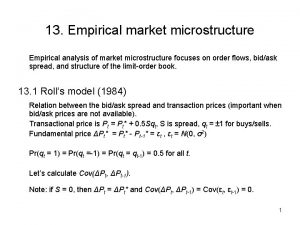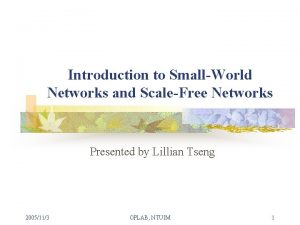UNCLASSIFIED Worm Spread in ScaleFree Networks A Model










![Relation to Epidemic Models • Lemma [Griffin & Brooks 2006]: If G is an Relation to Epidemic Models • Lemma [Griffin & Brooks 2006]: If G is an](https://slidetodoc.com/presentation_image_h2/2e87867a707f255328ba96c468b5b63c/image-11.jpg)
![Infection Potential • Theorem [Griffin & Brooks 2006]: If 2< < 0, and for Infection Potential • Theorem [Griffin & Brooks 2006]: If 2< < 0, and for](https://slidetodoc.com/presentation_image_h2/2e87867a707f255328ba96c468b5b63c/image-12.jpg)
![Rate of Infection • Theorem [Griffin & Brooks]: Suppose that the rate of infection Rate of Infection • Theorem [Griffin & Brooks]: Suppose that the rate of infection](https://slidetodoc.com/presentation_image_h2/2e87867a707f255328ba96c468b5b63c/image-13.jpg)

![Infection Countermeasures • Theorem [Griffin & Brooks 2006]: Centralized patch distribution runs in O(|G|), Infection Countermeasures • Theorem [Griffin & Brooks 2006]: Centralized patch distribution runs in O(|G|),](https://slidetodoc.com/presentation_image_h2/2e87867a707f255328ba96c468b5b63c/image-15.jpg)

- Slides: 16

UNCLASSIFIED Worm Spread in Scale-Free Networks A Model Using Random Graph Theory PRESENTED TO: CSIIR Workshop Oak Ridge National Lab PRESENTED BY*: Christopher Griffin Penn State Applied Research *Richard R. Brooks of Clemson University contributed to this study. 1

Goals of Presentation • Summarize the epidemiological models of worm spread in the Internet • Introduce Random Graphs as models of the Internet • Propose a natural model of worm spread using Random Graphs • Demonstrate quantitative results showing this model may be appropriate 2

Computer Worms • Computing a self-replicating program able to propagate itself across a network, typically having a detrimental effect. • The name 'worm' comes from The Shockwave Rider, a science fiction novel published in 1975 by John Brunner. • Researchers John F Shoch and John A Hupp of Xerox PARC chose the name in a paper published in 1982; The Worm Programs, Comm ACM, 25(3): 172 -180, 1982), and it has since been widely adopted. 3

Epidemic Models • Epidemiology: The study of the spread of disease in populations. • Diseases may spread quickly and then die out (Ebola) or remain endemic within a population (Chicken Pox) • Populations can be modeled in a number of ways: • “SI”, “SIS” or “SIR” models are most common. 4

Mathematical Epidemiology • Classical Mathematical Epidemiology Uses 3 Key Parameters in SIS/SIR Models: – R 0: The number of secondary infections that occur when one infective agent is introduced into a population. – (t): The average number of effective contacts an individual has during his/her infected period. – R(t) : The average number of secondary infections produced by an individual during his/her infected period. • In general, epidemic is only possible if R 0 > 1. 5

Scale-Free Networks • A graph G=(V, E) is scale free if the number of vertices with degree d follows an inverse power law. That is: • n(d) = k/d – n(d) is the number of vertices with degree d. – k is a constant of proportionality, and – is the scaling parameter. • Scale-free graphs have gained popularity in recent years. • Examples: The World Wide Web, Human Sexual Contacts, Protein-Protein Interaction Networks. 6

Worm Models with Epidemiology • R. Pastor-Satorras and A. Vespigani studied the spread of worms in Internet-like networks using classical mathematical epidemiology. – Differential Equation Model of Infection Spread – Mean-Field Theory Approximations • They show that for certain scale-free networks with scaling parameter < 3, epidemics will occur for all diseases with R 0 > 1. 7

OK, this model “looks” good. Why not use it? • Three reasons to search for a different model: – These models assume a completely mixed population. – Classical mathematical epidemiology assumes a fluid-like behavior of individuals. – R. Pastor-Satorras and A. Vespigani were studying general scale-free networks, not computer networks specifically. • Two dangers to note: – In the absence of ad hoc mesh networks, computers do not mix. – The effective R 0 is highly dependent on the initial infection position. 8

Graphs and Random Graphs • A graph G=(V, E) is said to have a giant component H if H is a subgraph and contains a majority of the vertices of G. • A random graph is a misnomer. A random graph is a tuple ( , p), where is a set of graphs and p is an appropriately defined probability measure on a sigma algebra of . • The most widely studied random graph family is (n, p), where each graph in has n vertices when any graph G is chosen from the probability that there is an edge between two arbitrarily chosen vertices is p. • These are the Erdös-Renyi Random Graphs. 9

Random Graph Model of SF Graphs • Aiello et al. have formulated a random graph model of SF graphs. • Let ( , ) be the collection of graphs whose degree distribution follows the curve n(d)= exp( )/d . – Here x denotes the greatest integer lower bound for x. – Aiello et al. have shown that this definition is mathematically sufficient and that a reasonable probability measure can be defined. • In this model, (roughly) controls the size of the graph while controls the scaling of the graph. 10
![Relation to Epidemic Models Lemma Griffin Brooks 2006 If G is an Relation to Epidemic Models • Lemma [Griffin & Brooks 2006]: If G is an](https://slidetodoc.com/presentation_image_h2/2e87867a707f255328ba96c468b5b63c/image-11.jpg)
Relation to Epidemic Models • Lemma [Griffin & Brooks 2006]: If G is an element of ( , ), and vertices of G are uniformly randomly kept with probability 0<p≤ 1 to produce G’, then a. s. G’ has the same properties as G. • Theorem [Griffin & Brooks 2006]: For any infection in graph G ( , ) with >2, and with nodes having susceptibility probability p, then for all time 11
![Infection Potential Theorem Griffin Brooks 2006 If 2 0 and for Infection Potential • Theorem [Griffin & Brooks 2006]: If 2< < 0, and for](https://slidetodoc.com/presentation_image_h2/2e87867a707f255328ba96c468b5b63c/image-12.jpg)
Infection Potential • Theorem [Griffin & Brooks 2006]: If 2< < 0, and for any infectious agent with infection probability p, a. s. limt i(t) = p. Where i(t) is the proportion of infected nodes. • This result is particularly interesting: – Often the affects of Internet worms have been blamed on the monoculture of Microsoft products. – This theorem suggests that even in the absence of a network monoculture, for appropriate Internet structures, 100% infection would occur among the susceptible nodes. 12
![Rate of Infection Theorem Griffin Brooks Suppose that the rate of infection Rate of Infection • Theorem [Griffin & Brooks]: Suppose that the rate of infection](https://slidetodoc.com/presentation_image_h2/2e87867a707f255328ba96c468b5b63c/image-13.jpg)
Rate of Infection • Theorem [Griffin & Brooks]: Suppose that the rate of infection is constant, then the time required to achieve total infection is a. s. O(log|G|). • Suppose that the infection rate is r(t), then: • For certain r(t) we can obtain an “S” curve matching the data. • This gives a natural model of infection rate that matches the given data and does not appeal to continuous mixing models. 13

Comparison of Approaches • When we try a model: • We obtain: • The model is seen to be imperfect because the true “logarithmic rate” does have hump, but it is probably not Gaussian in nature. G/B puts the diameter of this monitored network at ~13 --this is a bit smaller than most estimates of the diameter of the Internet. • 14
![Infection Countermeasures Theorem Griffin Brooks 2006 Centralized patch distribution runs in OG Infection Countermeasures • Theorem [Griffin & Brooks 2006]: Centralized patch distribution runs in O(|G|),](https://slidetodoc.com/presentation_image_h2/2e87867a707f255328ba96c468b5b63c/image-15.jpg)
Infection Countermeasures • Theorem [Griffin & Brooks 2006]: Centralized patch distribution runs in O(|G|), while decentralized “white worms” can inoculate machines in time O(log|G|) assuming a constant rate of transmission. • This theorem was “experimentally verified” by Chen and Carley (2005). • What does this mean? – Centralized patch distribution is inefficient but… – Centralized patch distribution is safe. – Inefficiency is the cost of safety. • Here is a real tradeoff: either we distribute patches quickly and prevent global infection at the risk of creating patch-based errors or we live with our current security model. 15

Conclusions • Infectious agents in computer networks can be modeled using natural “random graph” models. • These models are more appropriate than continuous mixing models. • For scale-free random graph models, total infection is a. s. whenever < 0, hence infections are a function of network structure as much as pathogen. • Infection rates can be well described using the random graph model. • There is a natural trade-off between security countermeasures efficiency and safety. This confirms experimental results presented by Chen and Carley. 16
 Pharynx function earthworm
Pharynx function earthworm Unclassified position
Unclassified position Sbu/noforn
Sbu/noforn Unclassified
Unclassified Unclassified fouo
Unclassified fouo Eric carstensen
Eric carstensen Cui//sp-prvcy
Cui//sp-prvcy Scif prohibited items list
Scif prohibited items list Nato unclassified
Nato unclassified Ngr 600-22
Ngr 600-22 National special security event list
National special security event list Unclassified/fouo
Unclassified/fouo Nato unclassified
Nato unclassified Cui
Cui Difference between datagram and virtual circuit network
Difference between datagram and virtual circuit network Basestore iptv
Basestore iptv Empirical market microstructure
Empirical market microstructure































